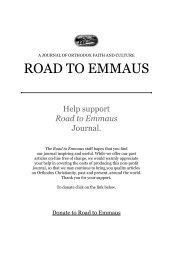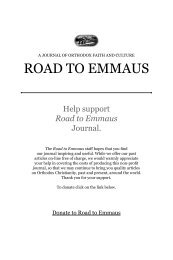RTE No 20 Interior - Road to Emmaus Journal
RTE No 20 Interior - Road to Emmaus Journal
RTE No 20 Interior - Road to Emmaus Journal
You also want an ePaper? Increase the reach of your titles
YUMPU automatically turns print PDFs into web optimized ePapers that Google loves.
<strong>Road</strong> <strong>to</strong> <strong>Emmaus</strong> Vol. VI, <strong>No</strong>. 2 (#21)FROM JAINISM TO ORTHODOXYful, and dispassionate. The way we portray the “gates of the senses” inOrthodox iconography – small ears, noses, lips, but then large eyes <strong>to</strong> symbolizethat they are gazing in<strong>to</strong> the spiritual world is similar <strong>to</strong> the Jain practiceof enlarging the eyes and elongating the ears <strong>to</strong> symbolize enlightenment.ELESA: I also find the role and conduct of Jain monks and nuns <strong>to</strong> be very similar<strong>to</strong> Orthodox monastics. They are our models and guides. You go <strong>to</strong> Jainmonasteries in India <strong>to</strong> see what Jainism is about, <strong>to</strong> reflect on your own life.On this pilgrimage <strong>to</strong> Serbian monasteries, I’ve found that this is very importantin Orthodoxy <strong>to</strong>o; it’s in monasteries that you see a deeper Orthodoxy.<strong>RTE</strong>: Did you have any contact with the Jain monastics, besides those thatcame for food?ELESA: Yes, of course. We have a tradition that on days like your birthday,or if you need a special blessing, you go <strong>to</strong> where the monks and nuns resideand they will bless you by putting vaskep, a yellow powder that looks likewheat, on your head. They did this for me many times. They are very, verykind and when you talk <strong>to</strong> them (you aren’t allowed <strong>to</strong> <strong>to</strong>uch them) they areextremely humble. They never said anything <strong>to</strong> me that was particularlypersonal, but I was always <strong>to</strong>uched by their humility and their peacefulcountenances. I liked being around them very much.<strong>RTE</strong>: Are the monastics also divided in<strong>to</strong> groups of idolaters and non-idolaters?ELESA: Yes, the one group will not engage in idolatry at all, nor do they wearclothes.SYMEON: The ideal here is poverty, of not owning a lot of possessions, andthis group considers owning clothes <strong>to</strong> be <strong>to</strong>o much of a luxury.ELESA: The idea behind this is that <strong>to</strong> really humble yourself you should notbe ashamed of your body. They see shame as self-consciousness, a kind ofvanity.SYMEON: Also, in Indian culture the clothed monastics always wear white,while in ours, they wear black. But the symbolism is the same, because inJainism, white is a symbol of mourning. Everyone wears white <strong>to</strong> funeralsand widows wear white for an entire year.<strong>RTE</strong>: Do Jains pray for the dead?ELESA: Yes, they do. On the anniversary of my father’s death every year wehave what we call aarti where a prayer is said for him in the temple and thena bell is rung a certain number of times. This is done annually for everyonein our family who has died. Our family is associated with a particular templenear our home where the prayer is always sung.<strong>RTE</strong>: Is there any form of confession?ELESA: We don’t practice confession in the Christian sense; however, if thereare things that trouble us, secular or religious, some Jains will go <strong>to</strong> themonastics about it.In Jainism there is also a day when we ask forgiveness of everyone, likeour Orthodox Forgiveness Sunday. You go <strong>to</strong> everyone you know, even casually,whether he is a Jain, Hindu, Muslim or Christian, and you bow <strong>to</strong> himand say, “If I have ever offended you knowingly or unknowingly, please forgiveme.”Another outward similarity I’ve noticed between Jainism and Orthodoxyis the Serbian practice of having family saints, called Slavas. For the Serbs,these aren’t saints who are picked anew in each generation, they are saintswho were given as protec<strong>to</strong>rs <strong>to</strong> a particular group or tribe the day they werebaptized centuries ago. Serbs pray for all of their deceased relatives back <strong>to</strong>that point of that original baptism. In a similar way, Jain families have akuldevi, usually a goddess that the family considers <strong>to</strong> be their patron. WhatI mean by a goddess here is very different from what we would think of as afemale equivalent of God. We have many minor prophets and some of themwere women; they were human beings who became enlightened, their birthswere fore<strong>to</strong>ld by prophets.On a Jain family feast day, like a Serbian slava, food is prepared for weeksin advance, and the doors are thrown open <strong>to</strong> anyone who wants <strong>to</strong> come.The small lanes of the gated communities are covered with awnings orbranches <strong>to</strong> provide shade and lined with carpeted platforms for people <strong>to</strong>sit on. Servers come by giving out food until you burst. It is not only for familyor friends, but for anyone who comes off the street.<strong>RTE</strong>: Wonderful. Speaking of praying <strong>to</strong> the kuldevi, did the Christian venerationof the Mother of God pose any difficulties for you?2829










